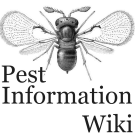Publications for:
pest = Trioza apicalis
crop = Carrot (Daucus carota)
found 19 publications:2021
Spreading of Trioza apicalis and development of "Candidatus Liberibacter solanacearum" infection on carrot in the field conditionsAnnals of Applied Biology (2021) 178 (1), 39-50
publishers website - pestinfo wiki
Exceeding the threshold value for Trioza apicalis Förster 1848 in carrot fields did not cause damage as revealed during monitoring in Germany from 2017–2020
Journal of Plant Diseases and Protection (2021) 128 (3), 865-870
publishers website - pestinfo wiki
Dual transcriptional profiling of carrot and ‘Candidatus Liberibacter solanacearum’ at different stages of infection suggests complex host-pathogen interaction
Molecular Plant-Microbe Interactions (2021) 34 (11), 1281-1297
publishers website - pestinfo wiki
2020
Assessment of the efficiency of different control programs to reduce Trioza apicalis Först. (Triozidae: Hemiptera) feeding damage and the spread of "Candidatus Liberibacter solanacearum" on carrots (Daucus carota ssp. sativus L.)Annals of Applied Biology (2020) 177 (2), 166-177
publishers website - pestinfo wiki
2019
Identification of sesquisabinene B in carrot (Daucus carota L.) leaves as a compound electrophysiologically active to the carrot psyllid (Trioza apicalis Förster)Chemoecology (2019) 29 (3), 103-110
publishers website - pestinfo wiki
2017
Frequency and occurrence of the carrot pathogen ‘Candidatus Liberibacter solanacearum’ haplotype C in FinlandPlant Pathology (2017) 66 (4), 559-570
publishers website - pestinfo wiki
2015
First report of ‘Candidatus Liberibacter solanacearum’ associated with psyllid-infested carrots in GermanyPlant Disease (2015) 99 (9), p.1269
publishers website - pestinfo wiki
2014
Survey of "Candidatus Liberibacter solanacearum" in carrot crops affected by the psyllid Trioza apicalis (Hemiptera: Triozidae) in NorwayJournal of Plant Pathology (2014) 96 (2), 397-402
publishers website - pestinfo wiki
Different symptoms in carrots caused by male and female carrot psyllid feeding and infection by 'Candidatus Liberibacter solanacearum'
Plant Pathology (2014) 63 (4), 812-820
publishers website - pestinfo wiki
2013
Migration flight of carrot psyllid (Trioza apicalis) at various latitudes is independent of local phenologyPlant Protection Science (2013) 49 (4), 187-192
publishers website - pestinfo wiki
2012
Effects of carrot psyllid (Trioza apicalis) feeding on carrot yield and content of sugars and phenolic compoundsAnnals of Applied Biology (2012) 161 (1), 68-80
publishers website - pestinfo wiki
2011
Molecular detection of aster yellows phytoplasma and "Candidatus Liberibacter solanacearum" in carrots affected by the psyllid Trioza apicalis (Hemiptera: Triozidae) in FinlandJournal of Plant Pathology (2011) 93 (3), 697-700
pestinfo wiki
Biology of Trioza apicalis - a review
Plant Protection Science (2011) 47 (2), 68-78
publishers website - pestinfo wiki
2010
Association of 'Candidatus Liberibacter solanacearum' with the psyllid, Trioza apicalis (Hemiptera: Triozidae) in EuropeJournal of Economic Entomology (2010) 103 (4), 1060-1070
publishers website - pestinfo wiki
First report of 'Candidatus Liberibacter solanacearum' associated with psyllid-affected carrots in Europe
Plant Disease (2010) 94 (5), p. 639
publishers website - pestinfo wiki
2008
Physiological state of female and light intensity affect the host-plant selection of carrot psyllid, Trioza apicalis (Hemiptera: Triozidae)European Journal of Entomology (2008) 105 (2), 227-232
pestinfo wiki
2007
Short feeding period of carrot psyllid (Trioza apicalis) females at early growth stages of carrot reduces yield and causes leaf discolourationEntomologia Experimentalis et Applicata (2007) 125 (3), 277-283
publishers website - pestinfo wiki
Carrot psyllid (Trioza apicalis) winter habitats - insights in shelter plant preference and migratory capacity
Journal of Applied Entomology (2007) 131 (3), 174-178
publishers website - pestinfo wiki
2002
Essential oil composition in leaves of carrot varieties and preference of specialist and generalist sucking insect herbivoresAgricultural and Forest Entomology (2002) 4 (3), 211-216
publishers website - pestinfo wiki
